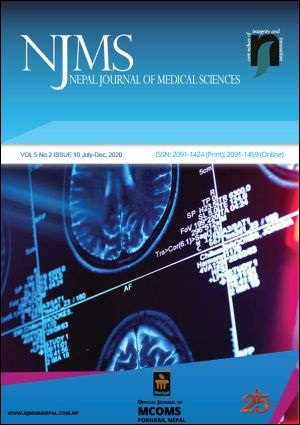Endoscopic Sphenopalatine Artery Ligation in Posterior Epistaxis
DOI:
https://doi.org/10.3126/njms.v5i2.36705Keywords:
Endoscopy, Posterior Epistaxis, Sphenopalatine Artery LigationAbstract
Introduction: Posterior epistaxis brings us with a more challenging condition that can even threaten the life of a patient. Approaching the posterior nasal cavity is not an easy task because of its anatomical complexity and impending vision by turbinate. Increase endoscopic anatomic details of lateral nasal wall and endoscopic expertise with high definition camera leads to a higher success rate of endoscopic sphenopalatine artery ligation.
Methods: This prospective study was conducted in patients with refractory posterior epistaxis between January 2017 to December 2019. All patient who had undergone Endoscopic Sphenopalatine artery ligation were included in this study. The site of bleeding was confirmed with the help of a rigid endoscope. Bipolar cauterization or clipping was performed to stop bleeding. Data analysis was done by using SPSS 26.0 version.
Results: Twenty nine patients who had undergone Endoscopic sphenopalatine artery for posterior epistaxis were included during this study period. The mean age of the patient was 53.31 ± 18.65years. The site of bleeding was mostly from the left in 20 (75.9%) cases and 10 (34.4%) cases had severe bleeding that needed a blood transfusion. No recurrence of bleeding was found during follow up period. The severity of bleeding was significantly correlated with the age of patients (p<0.003). Out of 29 patient, 27 patients had undergone bipolar diathermy and 2 patients clipping was done.
Conclusion: Sphenopalatine artery ligation is an effective management strategy for surgical control of refractory epistaxis. The early timing of sphenopalatine artery ligation may lead to reductions in length of stay.
Downloads
Downloads
Published
How to Cite
Issue
Section
License
Copyright © by Nepal Journal of Medical Sciences. The ideas and opinions expressed by authors of articles summarized, quoted, or published in full text in this Journal represents only opinions of authors and do not necessarily reflect the official policy of Nepal Journal of Medical Sciences or the institute with which the author(s) is (are) affiliated, unless so specified.




